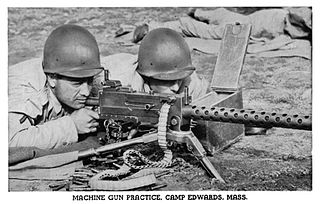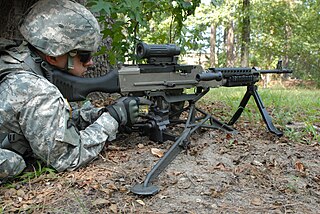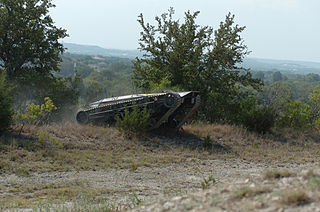
The M102 is a light, towable 105 mm howitzer used by the United States Army in the Vietnam War, the First Gulf War, and the Iraq War.

The Carl Gustaf recoilless rifle is an 84-mm man-portable reusable anti-tank weapon produced by Saab Bofors Dynamics in Sweden. Introduced in 1946, it was one of the many recoilless rifle designs of that era. While similar weapons have generally disappeared from service, the Carl Gustaf is still being made and remains in widespread use today. The Carl Gustaf is a lightweight, low-cost weapon that uses a wide range of ammunition, which makes it extremely flexible and suitable for a wide variety of roles.
The M60, officially the United States Machine Gun, Caliber 7.62 mm, M60, is a family of American general-purpose machine guns firing 7.62×51mm NATO cartridges from a disintegrating belt of M13 links. There are several types of ammunition approved for use in the M60, including ball, tracer, and armor-piercing rounds.

The M240, officially the Machine Gun, 7.62 mm, M240, is the US military designation for the FN MAG, a family of belt-fed, gas-operated medium machine guns that chamber the 7.62×51mm NATO cartridge.

The PK, is a 7.62×54mmR general-purpose machine gun designed in the Soviet Union and currently in production in Russia. The original PK machine gun was introduced in 1961 and then the improved PKM in 1969 to replace the SGM and RP-46 machine guns in Soviet service. It remains in use as a front-line infantry and vehicle-mounted weapon with Russia's armed forces. The PK has been exported extensively and produced in several other countries under license.

The Ares Defense Shrike 5.56 is an air-cooled, dual-feed rifle for semi or full-auto configurations that fires the 5.56×45mm NATO cartridge. The Shrike 5.56 can be supplied as a complete weapon, or as an upper receiver “performance upgrade kit” to existing M16-type service rifles and carbines.
The M1917 Browning machine gun is a heavy machine gun used by the United States armed forces in World War I, World War II, and Korea; it has also been used by other nations. It was a crew-served, belt-fed, water-cooled machine gun that served alongside the much lighter air-cooled Browning M1919. It was used at the battalion level, and often mounted on vehicles. There were two main iterations: the M1917, which was used in World War I and the M1917A1, which was used thereafter. The M1917, which was used on some aircraft as well as in a ground role, had a cyclic rate of 450 rounds per minute. The M1917A1 had a cyclic rate of 450 to 600 rounds per minute.

The Mark 48, or Mk 48, or Maximi is a lightweight belt-fed machine gun, firing 7.62×51mm NATO cartridges from a disintegrating belt of ammunition.

The M2 Tripod is a U.S. machine gun tripod originally used with the Browning M1919 infantry machine gun. Since then, it has seen several redesigns, but remained largely the same. In this fashion, the M2 tripod has seen combat service in every conflict that the U.S. Army and Marine Corps has been involved in since World War II. It has also been widely used by numerous other nations, such as U.S. Allies in various wars, especially those countries that used the same machine guns as the United States military.

The Common Remotely Operated Weapon Station (CROWS) is a remote weapon station systems used by the US military on its armored vehicles and ships. It allows weapon operators to engage targets without leaving the protection of their vehicle. The US military has fielded both the M101 CROWS and M153 CROWS II systems.

The Protector Remote Weapon Station is a remotely controlled weapons station (RWS) that can be mounted to vehicles and stationary platforms. It is manufactured by Kongsberg Defence Systems of Norway and Thales Group of France.

The LSAT light machine gun is a component of the Lightweight Small Arms Technologies (LSAT) program. The purpose of the program was to develop a lighter, yet highly reliable light machine gun (LMG). The program was initiated in 2004, when the Joint Service Small Arms Program (JSSAP) challenged the American defence industry to develop a lighter small arms and also design lighter ammunition.

The M249 light machine gun (LMG), formerly designated the M249 Squad Automatic Weapon (SAW) and formally written as Light Machine Gun, 5.56 mm, M249, is the American adaptation of the Belgian FN Minimi, a light machine gun manufactured by the Belgian company FN Herstal (FN). The M249 is manufactured in the United States by the local subsidiary FN Manufacturing LLC in Columbia, South Carolina and is widely used in the U.S. Armed Forces. The weapon was introduced in 1984 after being judged the most effective of a number of candidate weapons to address the lack of automatic firepower in small units. The M249 provides infantry squads with the high rate of fire of a machine gun combined with accuracy and portability approaching that of a rifle.

The M192 Lightweight Ground Mount is a tripod fielded by the United States armed forces. It was designed and developed by Capco, Incorporated under contract through Picatinny Arsenal to replace the M122 tripod. The United States Army named the tripod one of 2005's top ten inventions. It was designed for use with the M249, M240B, and M240L.
A weapon mount is an assembly used to hold a weapon, typically a gun. Weapon mounts can be broken down into two categories: static mounts and non-static mounts.

The Ripsaw is a developmental unmanned light tank designed and built by Howe & Howe Technologies for evaluation by the United States Army.

The M3 tripod is a weapon mount used on the M2HB Browning machine gun and the Mk 19 grenade launcher. The M3 tripod has a total weight of 20 kilograms. The M205 tripod, formerly the XM205, is intended to replace it.
The M63 ground mount is a four-legged anti-aircraft weapon mount used on the M2HB Browning machine gun.
Air Warrior (AW) is a modular, integrated, rapidly reconfigurable combat aircrew ensemble designed for U.S. Army aircrews. Previous aviation life support equipment consisted of a non-integrated assemblage of protective and survival gear. AW uses a systems approach to equipping the aircrew and closes the capability gap between human and machine. Fielded incrementally in blocks to rapidly provide enhanced capabilities to the warfighter, AW leverages and integrates clothing and equipment, such as the Army Aircrew Combat Uniform and ballistic protection, from other product managers. As of April 2010, more than 18,000 AW systems had been fielded in support of OIF and OEF.














